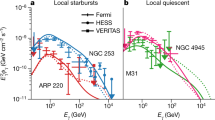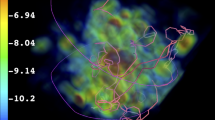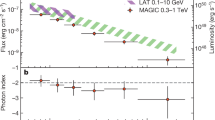Abstract
BECAUSE the Solar System lies in a spiral arm of our Galaxy, much of the γ-ray flux arriving at large angles to the galactic plane is of local origin. We have tried to calculate this contribution to the flux, and find that the effect is particularly pronounced for γ rays of energy > 100 MeV. This implies a steeper spectrum for extragalactic γ rays than has been hitherto expected.
This is a preview of subscription content, access via your institution
Access options
Subscribe to this journal
Receive 51 print issues and online access
$199.00 per year
only $3.90 per issue
Buy this article
- Purchase on Springer Link
- Instant access to full article PDF
Prices may be subject to local taxes which are calculated during checkout
Similar content being viewed by others
References
Fichtel, C. E., et al., Astrophys. J., 198, 163 (1975).
Stecker, F. W., Nature phys. Sci., 241, 74 (1973).
Stecker, F. W., Morgan, D. L., and Bredekamp, J., Phys. Rev. Lett., 27, 1469 (1971).
Strong, A. W., Wolfendale, A. W., and Wdowczyk, J., Nature, 241, 109 (1973).
Nissen, D., and Thielheim, K. O., Astrophys. Space Sci., 33, 441 (1975).
Gould, R. J., Phys. Rev., 185, 72 (1969).
Stecker, F. W., Astrophys. J., 185, 499 (1973).
Ginzburg, V. L., Origin of Cosmic Rays (Pergamon, Oxford, 1964).
Fuchs, B., Schlickeiser, R., and Thielheim, K. O., Proc. 14th Int. Conf. Cosmic Rays, Munich, 12, 4078 (1975).
Fuchs, B., Schlickeiser, R., and Thielheim, K. O., Astrophys. J. (in the press).
Jenkins, E. B., and Savage, B. D., Astrophys. J., 187, 243 (1974).
Bohlin, R. C., Astrophys. J., 200, 402 (1975).
Fitzgerald, M. P., Astr. J., 73, 983 (1968).
Daltabuit, E., and Meyer, S., Astr. Astrophys., 20, 415 (1972).
Carruthers, G. R., Astrophys. J. Lett., 161, L81 (1970).
Hollenbach, D. J., Werner, M. W., and Salpeter, E. E., Astrophys. J., 163, 165 (1971).
Mezger, P. G., Proc. 14thlnt. Conf. Cosmic Rays, Munich, 11, 3643 (1975).
Cummings, A. C., Stone, E. C., and Vogt, R. E., 13th Int. Conf. Cosmic Rays, Denver, 1, 335 (1973).
Daugherty, J. K., Hartman, R. C., and Schmidt, P. J., Astrophys. J., 198, 493 (1975).
Bratolyubova-Tsulukidze, L. I., et al., Geomag. Aeron. (Soviet), 11, 585 (1971).
Schönfelder, V., and Lichti, G., Astrophys. J. Lett., 191, L1 (1974).
Author information
Authors and Affiliations
Rights and permissions
About this article
Cite this article
SCHLICKEISER, R., THIELHEIM, K. Steepening of the γ-ray background spectrum from local γ-ray production. Nature 261, 478–479 (1976). https://doi.org/10.1038/261478a0
Received:
Accepted:
Issue Date:
DOI: https://doi.org/10.1038/261478a0
This article is cited by
-
The gamma-ray luminosity of spiral galaxies. Its evolution and its contribution to the diffuse background above 100 MeV
Astrophysics and Space Science (1978)
-
Gamma-ray astrophysics
Space Science Reviews (1977)
-
Spatial distribution of high energy cosmic ray electrons perpendicular to the galactic plane
Astrophysics and Space Science (1977)
Comments
By submitting a comment you agree to abide by our Terms and Community Guidelines. If you find something abusive or that does not comply with our terms or guidelines please flag it as inappropriate.



